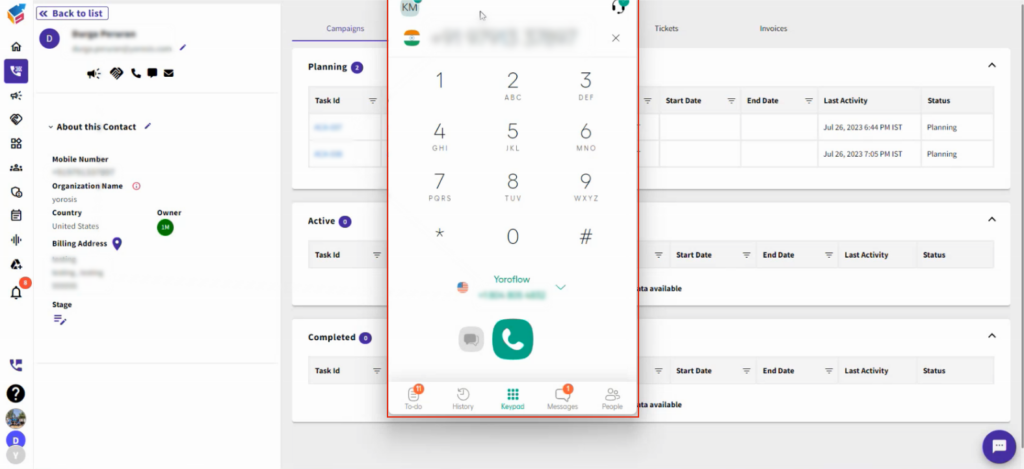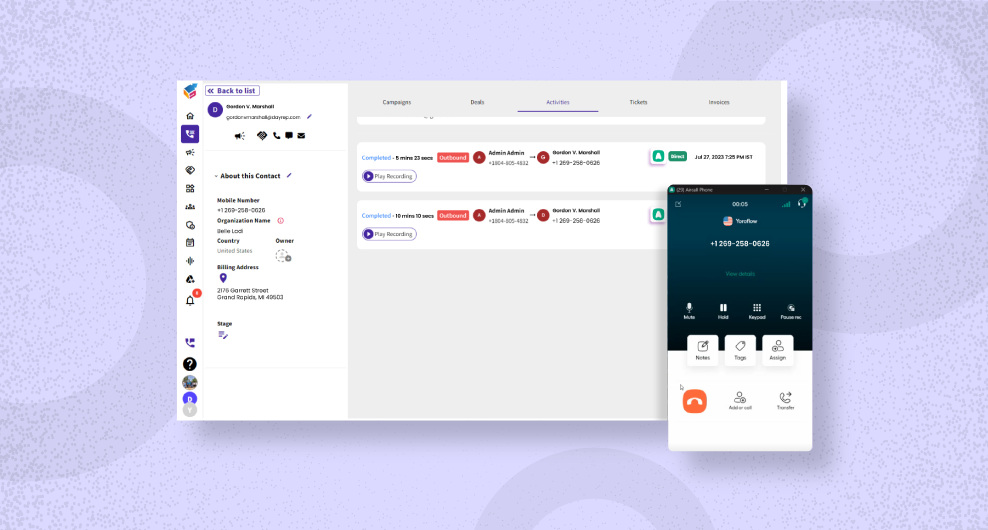Table of Contents
Crafting an efficient inbound call strategy goes beyond merely improving operational efficiency; it is about creating a culture of customer-centricity that permeates every aspect of a business. By prioritizing the needs of customers and aligning their strategies accordingly, organizations can unlock the full potential of their inbound call center, foster customer loyalty, and gain a competitive edge in the marketplace.
Whether you are an entrepreneur starting a new venture, a manager seeking to optimize your company’s call center operations, or a customer service professional looking to enhance your skills, this blog will provide you a complete guide you in crafting an efficient inbound call strategy.
Join us on this journey as we explore the foundations, strategies, and emerging technologies in inbound call management that will help your business deliver exceptional customer experiences and achieve sustainable success.
Let’s dive in and discover the transformative power of an efficient inbound call strategy together.
What are inbound calls?
Inbound calls indicate to phone calls that are received by a business or organization from external parties such as customers, clients, or prospects. These calls are initiated by individuals who want to make inquiries, seek assistance, place orders, or engage in any form of communication with the company.
Inbound calls are typically handled by customer service representatives or call center agents who are trained to provide support, answer questions, resolve issues, or offer information to the callers. These calls can cover a wide range of topics, including product inquiries, technical support, billing questions, call tracking, complaints, or general assistance.
Companies often set up dedicated phone lines or contact management to manage inbound calls effectively. They may also utilize interactive voice response (IVR) systems, which allow callers to navigate through a menu of options or speak to specific departments or individuals based on their needs. Additionally, inbound calls can be recorded for quality assurance purposes or to gather customer feedback and insights.
Inbound and outbound calling
Inbound and outbound calling are two different types of telephone communication:
- Inbound Calling: Inbound calling indicates to receiving phone calls from external parties. These calls are initiated by customers, clients, or other individuals who want to contact a business or organization for various reasons, such as inquiries, support, or placing orders. Inbound calls are typically received by customer service representatives or call center agents who handle the incoming calls and help, information, or resolution to the callers’ needs.
- Outbound Calling: Outbound calling, on the other hand, involves making phone calls to external parties. In this case, the business or organization takes the initiative to reach out to customers, prospects, or other contacts for different purposes. Outbound calls can be used for sales calls and marketing activities, such as telemarketing, lead generation, or customer acquisition. They can also be used for customer service follow-ups, appointment reminders, surveys, or any other form of proactive communication.

How many calls should an inbound agent take?
The number of calls that an inbound agent can handle will vary depending on several factors, including the complexity of the calls, the agent’s skill level, the industry, and the specific goals and guidelines set by the organization. It is important to strike a balance between the agent’s workload and their ability to provide quality service to callers.
While there is no fixed number of calls that an inbound agent should take, call centers and organizations often establish key performance indicators (KPIs) to measure and manage agent productivity. Some common KPIs related to call volume include:
- Average Handling Time (AHT): This is the average duration of a call, including talk time and any necessary after-call work. It helps determine how efficiently agents are handling calls and can influence the number of calls they can handle.
- Service Level: Service level measures the percentage of calls answered within a specified timeframe, often expressed as a percentage answered within a certain number of seconds (e.g., 80% of calls answered within 20 seconds). Achieving the desired service level may impact the number of calls an agent can handle simultaneously.
- Occupancy Rate: Occupancy rate represents the percentage of time an agent spends on call-related activities, including handling calls, after-call work, and waiting for calls. A high occupancy rate indicates a busy workload, which may limit the number of calls an agent can handle.
Ultimately, the goal is to find the right balance between call volume and quality of service. It is crucial to consider the complexity of the calls and ensure that agents have sufficient time to address customer needs effectively. Regular monitoring, feedback, and optimization of processes can help determine the optimal number of calls an inbound agent can handle while maintaining quality service standards.
How to craft an efficient inbound call strategy
Crafting an efficient inbound call strategy involves several key considerations to ensure effective communication and customer satisfaction.
Here are some steps to help you create an efficient inbound call strategy:
- Define Your Objectives: Start by clearly identifying your objectives for inbound calls. Are you aiming to provide exceptional customer service, resolve issues quickly, generate sales, or gather customer feedback? Defining your objectives will guide your strategy development process.
- Understand Your Customers: Gain a deep understanding of your customers, their needs, preferences, and pain points. This will help you tailor your inbound call strategy to address their specific requirements and provide personalized experiences.
- Implement an Effective Call Routing System: Set up a call routing system that directs calls to the appropriate departments or agents based on the caller’s needs. Use tools like interactive voice response (IVR) to allow callers to choose the right options and navigate through the menu easily.
- Train and Empower Your Agents: Provide comprehensive training to your customer service representatives or call center agents. Equip them with product knowledge, problem-solving skills, and effective communication techniques. Encourage them to take ownership of calls and empower them to resolve issues independently.
- Monitor and Optimize Performance: Regularly monitor and evaluate your inbound call performance metrics. Measure important factors such as call volume, average handling time, first-call resolution rate, customer satisfaction, and abandonment rate. Identify areas for improvement and implement strategies to optimize performance.
- Implement Quality Assurance Measures: Conduct regular quality assurance evaluations by reviewing recorded calls, assessing agent performance, and providing constructive feedback. This helps maintain consistency, identify training needs, and ensure adherence to company standards.
- Leverage Technology: Utilize technology to enhance your inbound call strategy. Implement customer relationship management (CRM) systems to track customer interactions, use call analytics to gain insights, and integrate tools like live chat or chatbots to provide additional omni-channels for customer support.
- Continuously Improve: Inbound call strategies should be dynamic and adaptable. Collect customer feedback, analyze trends, and make necessary adjustments to improve the efficiency of your strategy over time.
Remember that an efficient inbound call strategy is centered around providing exceptional customer experiences and resolving issues promptly. By understanding your customers, training your agents, monitoring performance, and leveraging technology, you can create a strategy that effectively meets customer needs and contributes to your overall business success.
Optimizing the use of technology
Optimizing the use of technology is crucial when developing an effective inbound call strategy. Technology plays a vital role in streamlining the inbound call process and ensuring prompt and efficient responses to customer inquiries.
When choosing the right technology for your inbound call strategy, it is important to consider factors such as cost, scalability, and user-friendliness. Additionally, assess whether the technology offers features that align with your business requirements. For instance, if you anticipate a high volume of calls, opting for a cloud telephony software solution can empower your team to handle the increased cloud calling flow effectively.

Cloud-based call center solutions provide benefits such as flexibility, scalability, and remote accessibility. They allow you to easily scale up or down based on call volume fluctuations and provide seamless access to customer data, call routing, and analytics. These solutions often integrate with CRM systems, enabling agents to access caller information and provide personalized customer support.
Additionally, consider implementing interactive voice response (IVR) systems, which offer menu options to callers and route them to the appropriate departments or agents efficiently. IVR systems can provide self-service options, reducing the need for agent intervention for routine inquiries.
Furthermore, consider utilizing customer service software that enables agents to access real-time customer information, track interactions, and manage customer data effectively. This software can facilitate efficient call handling, empower agents to provide personalized assistance, and enhance the overall customer experience.
Regularly evaluate and update your technology solutions to align with changing business needs and advancements in the industry. Stay informed about emerging technologies, such as artificial intelligence (AI) and chatbots, which can automate certain aspects of the inbound call process and further enhance efficiency.
By leveraging the right technology, you can optimize your inbound call strategy, improve response times, and deliver exceptional customer service.
Conclusion
Having an effective inbound call strategy is essential for businesses of all types and sizes to stay competitive in today’s market. With the availability of modern equipment and technological solutions, you can build a strong inbound call strategy that will benefit both your company and your customers. Take the advice provided earlier into consideration and implement it to enhance your strategy.
If you’re in need of inbound call software, consider giving the CRM platform ‘YoroCRM‘ a try today
It can provide you with the tools and features you need to optimize your inbound call operations and improve customer satisfaction.




